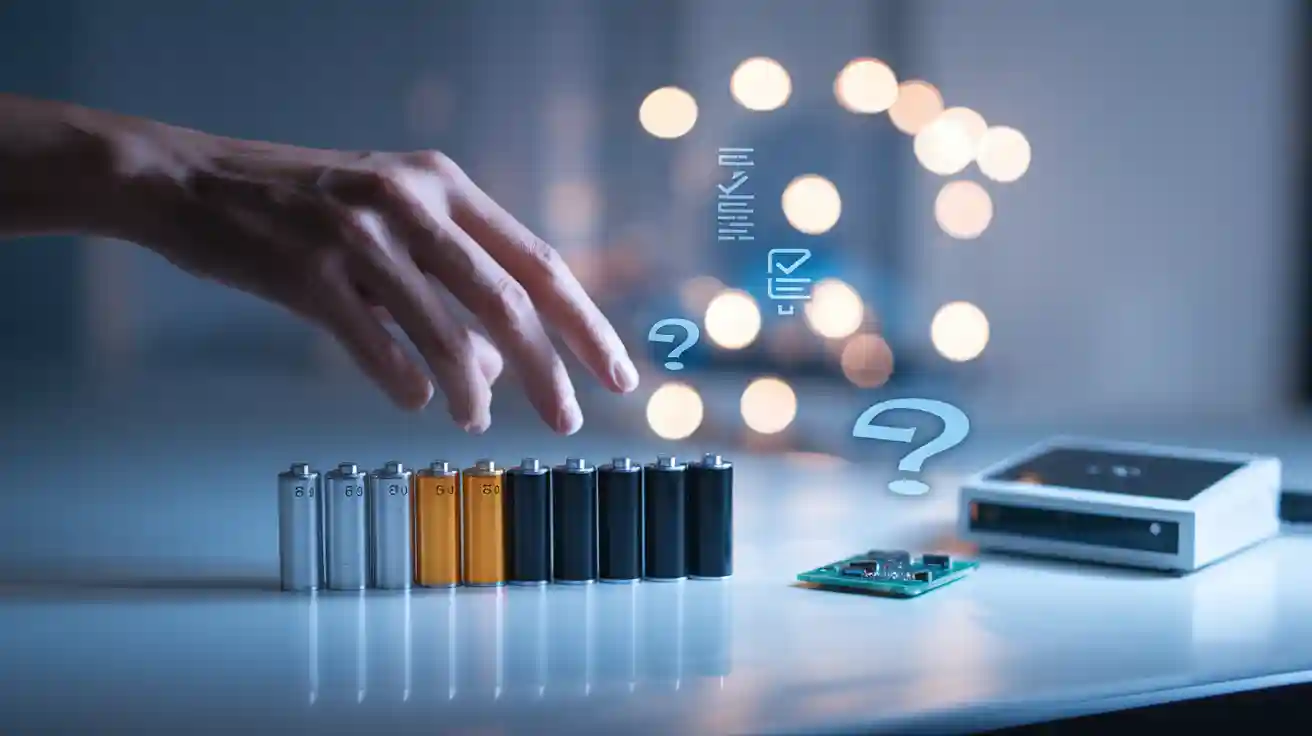
When you build a new project or upgrade a device, you want the best performance and safety. To choose the right battery, you must match your power, size, and safety needs with the right 3.7 volt lithium rechargeable battery. Many projects use a rechargeable lithium ion battery because it offers high energy in a small size. However, you need to watch for issues like stabilité thermique, form factor, and cycle life.
| Challenge | What It Means for Your Project |
|---|---|
| Stabilité thermique | Some 3.7 volt lithium rechargeable battery types can overheat. |
| Facteur de forme | Pouch cells are flexible but can be fragile. |
| Cycle de vie | Some batteries last much longer than others. |
Always check the brand and specs before you pick a rechargeable lithium ion battery.
Battery Basics
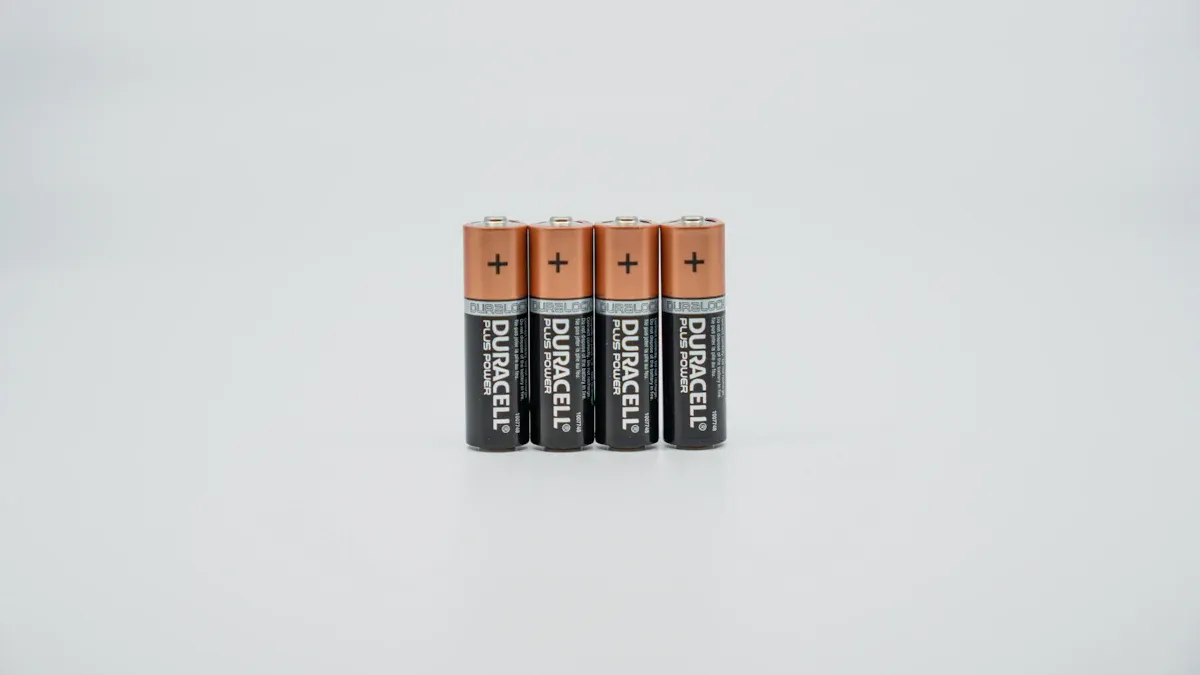
3.7V Rechargeable Lithium Ion Battery Types
You will find several types of 3.7 volt lithium rechargeable battery chemistries. Each type offers unique features for your project.
- Lithium Ion Polymer (LiPo) batteries use a polymer electrolyte. This design gives you flexible shapes and improved safety. LiPo batteries have high energy density and support fast charging.
- Lithium Cobalt Oxide (LiCoO2) batteries provide high specific energy but have a shorter lifespan and lower thermal stability.
- Lithium Nickel Manganese Cobalt Oxide (NMC) batteries deliver higher energy density and long cycle life.
- Lithium Manganese Oxide (LiMn2O4) batteries offer high thermal stability and fast charging.
- Lithium Iron Phosphate (LiFePO4) batteries give you good safety and long life, but a lower nominal voltage.
- Lithium Titanate (Li2TiO3) batteries stand out for excellent safety and very long cycle life.
| Chimie des batteries | Tension nominale (V) | Caractéristiques principales |
|---|---|---|
| Oxyde de lithium et de cobalt (LiCoO2) | ~3.6 | High specific energy, short lifespan, low thermal stability. |
| Phosphate de fer lithié (LiFePO4) | ~3.3 | Good safety, long life, moderate energy density. |
| Oxyde de lithium nickel manganèse cobalt (NMC) | ~3.7 | High energy density, long cycle life, moderate to high charge/discharge rates. |
| Oxyde de lithium et de manganèse (LiMn2O4) | ~3.8 | High thermal stability, fast charging, limited cycle life. |
| Lithium Titanate (Li2TiO3) | ~2.4 | Excellent safety, long cycle life, fast charging, high discharge current. |
Common Sizes and Formats
You can choose from many standard sizes for 3.7 volt lithium rechargeable battery cells. The most common formats include cylindrical, prismatic, and pouch cells. Cylindrical cells like 18650 and 14500 are popular for their durability and easy handling. Pouch cells offer flexibility for slim or custom-shaped devices.
| Battery Size | Diameter (mm) | Length (mm) | Applications typiques |
|---|---|---|---|
| 18650 | 18 | 65 | Laptops, flashlights, electric vehicles, vape devices |
| 14500 | 14 | 50 | Small flashlights, toys, portable medical devices |
| 26650 | 26 | 65 | Power tools, high-powered flashlights, solar storage |
| 16340 (RCR123A) | 16 | 34 | Cameras, tactical flashlights, portable gadgets |
| 21700 | 21 | 70 | Electric vehicles, power tools, high-performance flashlights |
| 10440 | 10 | 44 | Miniature electronics, small flashlights, media players |
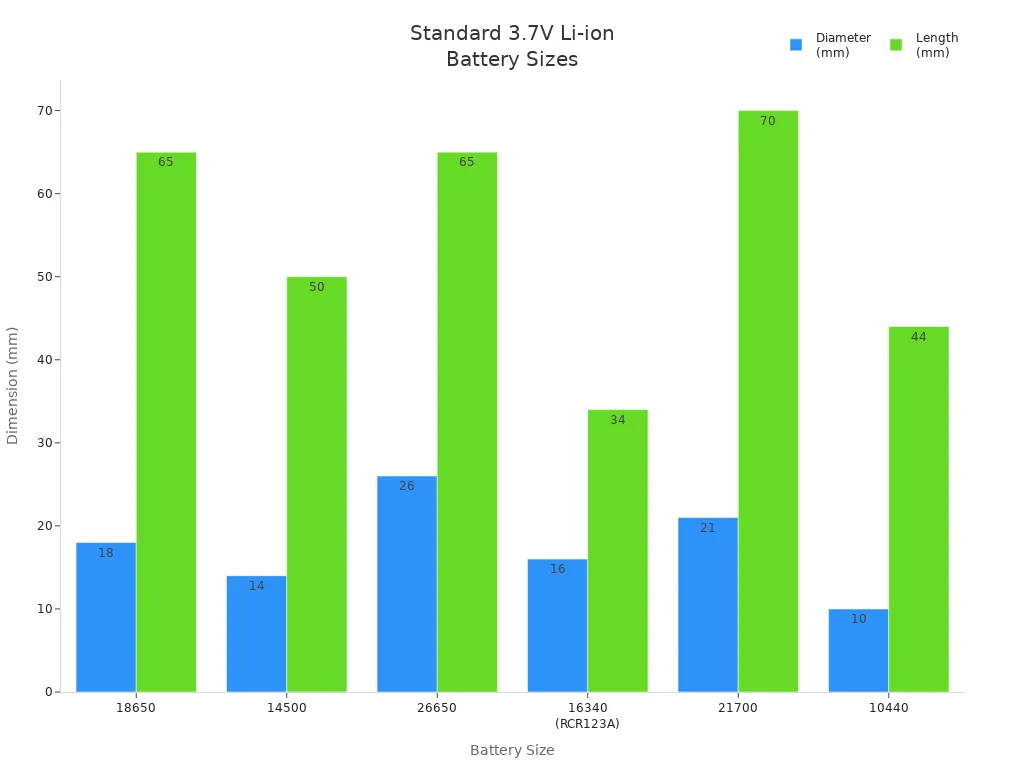
Tip: Always check the size and format before you select a 3.7 volt lithium rechargeable battery for your device.
Applications typiques
You will see 3.7 volt lithium rechargeable battery cells in many devices.
- Consumer electronics such as smartphones, tablets, laptops, and cameras use these batteries for their compact size and high energy density.
- Portable medical devices like glucose monitors and defibrillators rely on 3.7 v li-ion batteries for dependable power.
- Security systems, including surveillance cameras, need stable and continuous energy from a 3.7 volt lithium rechargeable battery.
- Outdoor gear, GPS devices, and high-lumen flashlights benefit from the reliable output of a 3.7v lithium battery.
- Power tools and robotics use these batteries for high power and portability.
- Drones, IoT sensors, and smart home devices depend on the lightweight design of a 3.7 volt lithium rechargeable battery.

You can trust this battery technology for its long cycle life, built-in safety features, and fast charging. The versatility of lithium ion batteries supports innovation in many fields.
Key Selection Criteria
Capacité et durée d'utilisation
When you select a 3.7 volt lithium rechargeable battery, you need to match its capacity to your device’s needs. Capacity tells you how much electric charge the battery can store. You measure this in milliampere-hours (mAh) or ampere-hours (Ah). A higher capacity means your device will run longer before you need to recharge. For example, a 2000mAh battery can deliver 2000 milliamps for one hour or 1000 milliamps for two hours. Devices that use more energy need batteries with larger capacities. If you pick a battery with too little capacity, your device may shut down early. If you choose one that is too large, it may not fit or could cause safety problems.
To find the right capacity, follow these steps:
- Find out how much current your device uses. Use the highest value for safety.
- Multiply the current (in amps) by the number of hours you want the device to run.
- Double the result for reliability and to handle unexpected loads.
- If your device uses a voltage converter, calculate in watt-hours (Wh) instead of ampere-hours (Ah).
- Multiply the battery voltage by its capacity to get watt-hours.
- Multiply your device’s voltage by its current to get power draw in watts.
- Divide the battery’s watt-hours by the device’s power draw to get the ideal runtime.
- Adjust for efficiency losses by multiplying the runtime by 0.8.
Tip: Always perform voltage and capacity testing to confirm your calculations before finalizing your battery choice.
Taux de décharge
Les discharge rate shows how fast a 3.7 volt lithium rechargeable battery can deliver power output to your system. You often see this as a C-rate. A higher discharge rate lets your device draw more current quickly, but it also creates more heat and stress inside the battery. This can shorten the battery’s life and increase safety risks. For example, at a 2C discharge rate, a lithium ion battery may only last about 450 cycles before losing half its capacity. Every 10°C rise above 25–30°C can cut battery life in half. High discharge rates can also cause overheating and mechanical stress, which may damage your system.
- Moderate discharge rates help your battery last longer and keep your system safe.
- Avoid over-discharging to reduce stress and improve longevity.
- Always check the maximum discharge rate in the battery’s datasheet.
| Chimie | Typical Discharge Rate (C) | Additional Notes |
|---|---|---|
| NMC | ~1C | Cycle life 500-2000 cycles; standard operation at 1C |
| LFP | ~1C | Cycle life 2000-5000 cycles; standard operation at 1C |
| LTO | Jusqu'à 10C | Supports fast charge/discharge; highest cycle life (~25,000 cycles) |
Note: Use voltage and capacity testing to make sure your battery can handle your system’s power output needs.
Size and Shape
You must make sure your 3.7 volt lithium rechargeable battery fits inside your device. Measure the space in your system and compare it to the battery’s size. Smaller batteries like the 10440 and 14500 types work best for compact devices. These batteries have a small diameter and length, so they fit into tight spaces. Larger batteries, such as the 18650 or 26650, offer more capacity but may be too big or heavy for your system.
| Type de batterie | Diameter (mm) | Length (mm) | Applications typiques | Influence on Selection for Compact Devices |
|---|---|---|---|---|
| 10440 | 10 | 44 | Small flashlights, portable media players, miniature devices | Smallest size, ideal for very compact devices with limited space |
| 14500 | 14 | 50 | Flashlights, toys, medical devices | Compact size similar to AA batteries, suitable for devices with moderate space constraints |
| 18650 | 18 | 65 | Laptops, flashlights, electric vehicles | Larger size, higher capacity but less suitable for very compact devices due to space and weight |
| 26650 | Larger than 18650 | Longer than 65 | Power tools, high capacity applications | Too large for compact devices, used where size is less constrained |

Cell format selection also matters. You can choose between cylindrical, prismatic, or pouch cells. Cylindrical cells are strong and easy to handle. Prismatic cells save space and fit well in slim devices. Pouch cells are flexible and work for custom shapes, but they can be fragile. Always match the cell format selection to your system’s design and performance needs.
Remember: The right cell format selection helps you balance size, weight, and capacity for your system.
Caractéristiques de sécurité
Safety is critical when you use a 3.7 volt lithium rechargeable battery in your system. Modern batteries include several protection features to prevent overcharging, overheating, and other risks. These features keep your system safe and extend battery life.
| Dispositif de sécurité | Description |
|---|---|
| PTC Device | Increases resistance to stop high current surges and prevent overheating. |
| Circuit Interrupt Device (CID) | Breaks the circuit if pressure inside the cell gets too high. |
| Safety Vent | Releases gas safely to stop the cell from bursting. |
| Electronic Protection Circuit | Cuts off charging if voltage goes above 4.30V. |
| Fuse | Stops current flow if the cell gets too hot. |
| Control Circuit | Prevents over-discharging by cutting off current at low voltage. |
Many 3.7 volt lithium rechargeable batteries use internal protection circuits with control ICs and MOSFET switches. These monitor voltage and current, disconnecting the battery if it gets too high. PTC devices and temperature sensors add extra layers of protection. Chargers with built-in safety features and Battery Management Systems (BMS) help prevent overcharging and overheating. Always follow safe charging practices and use batteries with these protection features in your system.
Note: A battery with a low self-discharge rate and strong protection features will last longer and keep your system safer.
Cycle de vie
Cycle life tells you how many times you can charge and discharge a 3.7 volt lithium rechargeable battery before it loses most of its capacity. A long cycle life means you can use the battery for many years. High discharge rates, heat, and overcharging can shorten cycle life. Batteries with a low self-discharge rate keep their charge longer when not in use, which is important for systems that sit idle for long periods.
You should always check the cycle life rating in the battery’s datasheet. Some lithium ion chemistries, like LTO, offer a very long cycle life, while others may wear out faster. Testing your system under real conditions helps you see how long your battery will last. Good cell format selection, such as choosing between cylindrical vs prismatic vs pouch cells, also affects cycle life and performance.
Tip: Use regular system testing to monitor battery health and replace batteries before they fail.
Match Specs
Project Power Needs
You need to start by understanding how much power your project will use. This step helps you choose the right lithium ion battery pack and avoid running out of energy too soon. Begin by listing all the parts in your system. Check how much current each part uses. For example, a small LED might use 20mA, while a microcontroller board could use 10mA. Add up the current for all parts to get the total current draw.
Next, think about how long you want your system to run before recharging. Multiply the total current by the number of hours you need. This gives you the minimum battery capacity in milliampere-hours (mAh). Double this number for reliability and to handle unexpected power output spikes.
You can also use tools and datasheets to check your numbers. A multimeter helps you measure real current draw. Some projects need to run for a few hours, while others must last all day. Always match the battery capacity to your system’s needs. If your project has high peak power output, make sure the battery can handle it without overheating.
Conseil : Calculate total energy by multiplying battery capacity (Ah) by voltage (V) to get watt-hours (Wh). Divide this by your system’s power use (W) to estimate runtime.
Space and Mounting
Space inside your device often limits your battery choices. You must measure the area where the lithium ion battery pack will fit. Compact devices need small batteries, but you still want enough capacity for your system. Prismatic and pouch cells work well in tight spaces because you can stack or shape them to fit. Cylindrical cells are strong but may waste space in slim designs.
Mounting also matters. Your battery pack design should keep the battery secure, even if your system moves or shakes. Use holders, brackets, or foam padding to stop the battery from shifting. If your project faces impacts or vibrations, pick a battery with a tough case and strong mounting.
Thermal management is important in small spaces. Batteries can get hot, especially in compact packs. Add cooling or vents if your system runs for a long time. Plan for swelling or expansion, which can happen if the battery overheats. Early in your battery pack design, think about voltage, capacity, safety, and heat control.
Note: Prismatic and pouch cells are best for custom lithium battery projects with unique shapes or limited space.
Environment Factors
Your system’s environment affects how well your lithium ion battery pack works. Temperature and humidity are the main factors. Cold weather can lower battery capacity, so your project may not run as long outside in winter. High heat can damage the battery or cause swelling. Always check the battery’s safe temperature range in the datasheet.
Humidity also matters. Too much moisture can cause corrosion or short circuits. Store and use your custom lithium battery in dry, cool places. If your system will be outdoors or in harsh conditions, pick a battery with extra protection against water and dust.
Tip: Both storage and operating conditions affect battery life. Keep your system in safe environments for best results.
Custom Lithium Battery Pack Design
Some projects need more than a single cell. You can build a custom lithium battery pack by connecting cells in en série ou en parallèle. Series connections raise the voltage, while parallel connections increase capacity and current. For example, a 2S2P pack has two cells in series and two in parallel. This setup gives you higher voltage and longer runtime.
When you design a custom lithium battery pack, always match cells by voltage, capacity, and internal resistance. This step prevents imbalance and keeps your system safe. Use secure wiring, like soldering or spot welding, to avoid loose connections. Always check polarity before connecting cells.
A Battery Management System (BMS) is key for protection. The BMS monitors voltage, current, and temperature. It stops charging if the battery gets too hot or overcharged. Regularly check your pack for swelling, heat, or drops in performance. Test your custom lithium battery under real loads to make sure it works well in your system.
For compact or odd-shaped projects, you can use coin cells, D-shaped cells, or LIR series cells. These options help you fit a lithium ion battery pack into small or unique spaces. Always balance your need for capacity, voltage, and safety with the space you have.
Callout: Customization lets you build custom battery packs that fit your project perfectly. Always focus on protection and system safety in every battery pack design.
Choosing a Rechargeable Lithium Ion Battery
Reputable Brands
You should always start your search for a rechargeable lithium ion battery by looking at trusted brands. Well-known manufacturers offer reliable performance and safety for your custom lithium battery projects. Here are some reputable options:
| Brand | Modèle | Capacité | Tension | Caractéristiques principales |
|---|---|---|---|---|
| Ufine | 503040 | 600mAh | 3.7V | Compact, stable voltage, built-in protection, lightweight |
| Streamlight | 22104 | 2600mAh | 3.7V | USB rechargeable, high energy, safety circuit |
| Nikon | EN-EL19 | 700mAh | 3.7V | Quick recharge, durable, for cameras |
| BENKIA | 18650 | 3600mAh | 3.7V | High capacity, 1000+ cycles, eco-friendly |
| LCLEBM | LCLEBM | 3800mAh | 3.7V | USB rechargeable, versatile, cost-effective |
| Lankoo | N/A | N/A | 3.7V | Compact CR2 type, lightweight |
| Vivitar | NB-6L/NB-6LH | 1700mAh | 3.7V | For Canon cameras, reliable, affordable |
| SAMCOM | FPCN10A | 3000mAh | 3.7V | For radios, consistent power |
| Motorola Solutions | PMNN4497 | 1800mAh | 3.7V | For business radios, durable |
Choosing a reputable brand helps you avoid problems in your lithium ion battery pack and ensures your custom lithium battery works as expected.
Datasheets and Certifications
Before you buy a custom lithium battery pack, always review the datasheet and check for certifications. Reliable batteries list important details and meet strict safety standards.
| Category | Détails |
|---|---|
| Certifications | TUV (UL 2054), UL1642, IEC 62133, UN 38.3, BIS |
| Rated Capacity | 2600mAh |
| Tension nominale | 3.7V |
| Tension de coupure de la décharge | 2.75V |
| Charging Voltage | 4.2V |
| Impedance | ≤100 mΩ |
| Charge/Discharge Rates | 0.2C-0.5C charge, up to 3.5A discharge |
| Operating Temperature | Charge: 0–45°C; Discharge: -20–60°C |
| Cycle de vie | 300+ cycles |
| Caractéristiques de sécurité | Protection board against overcharge, over discharge, short circuit |
Tip: Always use the recommended charger and follow the usage notes in the datasheet to protect your custom lithium battery.
Pricing and Value
The price of a rechargeable lithium ion battery depends on brand, capacity, form factor, and certifications. Bulk orders of standard lithium ion battery packs cost less per unit, while certified or specialty batteries cost more. Review the chart below to compare prices:
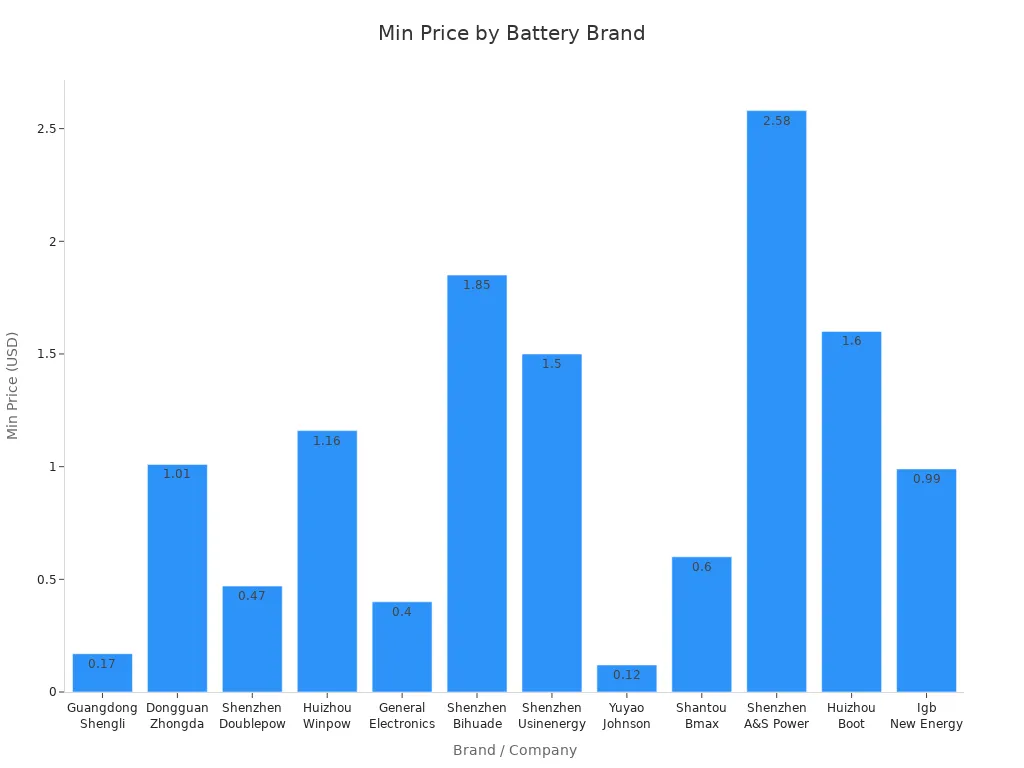
You should balance cost with quality and safety. For a custom lithium battery, paying a bit more for a certified product can save you from future problems.
Avoiding Counterfeits
Counterfeit batteries can damage your device or cause safety hazards. Follow these steps to avoid fake lithium ion battery packs:
- Buy only from trusted and authorized sellers.
- Check the battery’s capacity and continuous discharge rating.
- Choose protected batteries with built-in safety circuits.
- Inspect the wrapper for defects or missing safety information.
- Avoid deals with very low prices or unrealistic claims.
- Test voltage and capacity with a multimeter or battery tester.
Note: Careful inspection and buying from reputable sources help you get a safe, reliable custom lithium battery for your project.
Charging & Safety
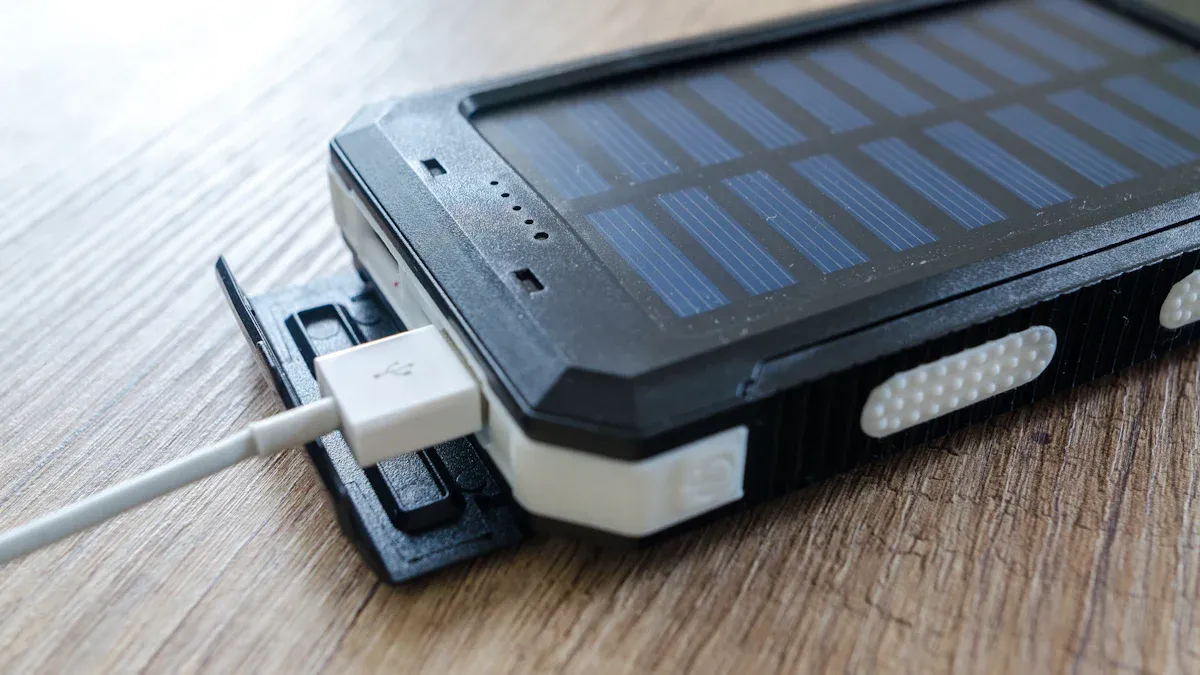
Pratiques de charge sûres
You must follow safe charging practices to keep your system running well and to protect your battery. Always use a charger designed for lithium-ion batteries. This charger should use constant current and constant voltage (CC/CV) charging. Never charge above 4.2 volts per cell. Overcharge and overdischarge protection are critical for safety and thermal stability. You should never leave your battery charging unattended. Recharge your battery before it drains completely. Avoid using chargers meant for other battery types. Regularly monitor your system during charging and keep a log of voltage readings. If you notice swelling, leaks, or strange smells, stop using the battery and replace it right away.
Tip: Always follow the manufacturer’s instructions for charging and handling to meet safety compliance requirements.
Stockage et manipulation
Proper storage and handling help your system last longer and work safely. Follow these steps:
- Store your battery at about 50% charge in a cool, dry place.
- Avoid deep discharging below 2.7–3.0 volts per cell.
- Never overcharge above 4.2 volts per cell.
- Use only chargers with overcharge and overdischarge protection.
- Regularly check battery voltage and condition.
- Inspect for swelling, leaks, or odd smells and replace if needed.
- Use a battery management system or protection circuit module.
- Follow all manufacturer instructions.
- Do not use mismatched chargers.
- Recharge before the battery drains fully.
- Educate users on safe handling and emergency response.
- Recycle used batteries properly.
Battery Pack Protection
Your system needs strong protection to prevent accidents and extend battery life. Most 3.7V lithium-ion battery packs use a protection circuit module. This module includes overcharge and overdischarge protection, over-current protection, and short circuit protection. Many systems also use a thermistor for temperature monitoring. A battery management system adds another layer of safety by monitoring voltage, current, and temperature. The table below shows common protection features:
| Protection Type | Key Features and Parameters |
|---|---|
| Protection contre les surcharges | Detects ~4.25V, releases at ~4.05V |
| Protection contre la surcharge | Detects ~2.5V, releases at ~3.0V |
| Over-current Protection | Detects ~11A, cuts off at 9-11A |
| Protection contre les courts-circuits | Fast response, stops current in microseconds |
| Protection de la température | Uses thermistor for real-time monitoring |
Testing your system with these protections ensures safe operation. Always use a battery management system for demanding applications like robotics or RC toys.
Élimination et recyclage
You must dispose of batteries safely to protect people and the environment. Follow these steps:
- Identify when to dispose: look for damage, swelling, or odd smells.
- Check local rules for disposal and recycling.
- Tape battery terminals and store in plastic bags or containers.
- Use certified recycling programs or drop-off bins.
Never throw lithium-ion batteries in household trash. Businesses must follow universal waste rules and label batteries correctly. Transporters must meet hazardous materials rules. Special care is needed for damaged or recalled batteries. Public education helps prevent fires and pollution.
Note: Safe disposal and recycling keep your system safe and help the planet.
Référence rapide
Liste de contrôle pour le choix de la batterie
You can use this checklist to make sure your system gets the right power and safety. Follow each step and check off as you go:
- List all parts in your system and measure their current draw.
- Calculate the total current and desired runtime for your system.
- Double your result for extra reliability.
- Choose a battery with enough capacity and the correct voltage.
- Check the size and shape to fit your system.
- Review the battery datasheet for discharge rate, cycle life, and safety features.
- Make sure the battery has built-in protection circuits.
- Select a reputable brand and confirm certifications.
- Plan for safe mounting and space for heat management in your system.
- Use proper chargers and follow safe charging practices.
- Complete testing and validating the battery pack before final use.
- Keep records of all testing results for your system.
Tip: Careful testing helps you catch problems early and keeps your system safe.
Erreurs courantes
Many people make mistakes when choosing and using a battery for their system. You can avoid these problems by learning what to watch for:
- Overcharging or letting the battery discharge too much can damage your system.
- Using a charger that does not match the battery’s voltage or current can cause overheating.
- Charging in very hot or cold places can shorten battery life and harm your system.
- Skipping testing steps may lead to system failure or safety risks.
- Ignoring the need for protection circuits can put your system in danger.
- Not checking the battery’s size or shape may cause fitting issues in your system.
- Forgetting to review the datasheet can result in missed warnings about safe use.
- Failing to do regular testing means you might miss early signs of trouble in your system.
- Using batteries from unknown brands increases the risk of system problems.
- Not storing the battery correctly can lead to leaks or loss of power in your system.
Remarque : Always use chargers that match your battery’s specs, avoid charging in extreme temperatures, and choose batteries with protection circuits. Careful testing and regular checks help your system last longer and work safely.
Selecting the right 3.7V rechargeable lithium ion battery means matching your device’s needs with the correct specs and safety features. Always check for protection circuits, use a battery management system, and follow safe handling rules like storing on nonflammable surfaces and wearing PPE. Review certifications such as UN38.3 and IEC 62133 for extra peace of mind. For custom projects or expert advice, you can reach out to companies like Emerging Power or consult specialists at Jensen Hughes.
| Resource | Service/Contact Info |
|---|---|
| Emerging Power | Custom design, (201) 441-3590, sales@emergingpower.com |
| Jensen Hughes | Risk consulting, lithium-ion safety experts |
FAQ
What does “3.7V” mean on a lithium-ion battery?
“3.7V” shows the battery’s nominal voltage. This is the average voltage during use. You should always match this voltage to your device’s needs for safe and reliable operation.
How do you know if a lithium-ion battery is safe to use?
Check for built-in protection circuits, certifications like UL or IEC, and a reputable brand. Avoid batteries with damaged wrappers or missing safety labels.
Tip: Always buy from trusted sellers.
Can you use any charger with a 3.7V lithium-ion battery?
No. You must use a charger made for lithium-ion batteries. The charger should have constant current and constant voltage (CC/CV) features. Using the wrong charger can damage the battery or cause safety risks.
How long does a 3.7V lithium-ion battery last?
Most 3.7V lithium-ion batteries last 300 to 2,000 charge cycles. The exact number depends on how you use, charge, and store the battery.
Note: Avoid deep discharges and overheating to extend battery life.
What should you do if your battery swells or leaks?
Stop using the battery right away. Move it to a safe place. Do not try to charge or use it again. Take it to a battery recycling center for safe disposal.

